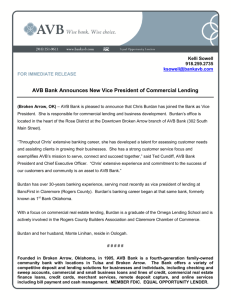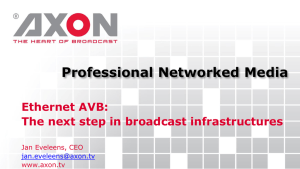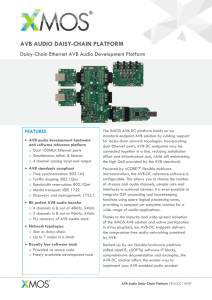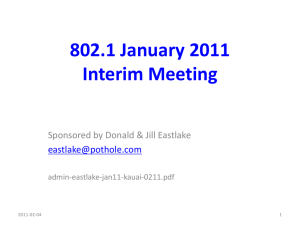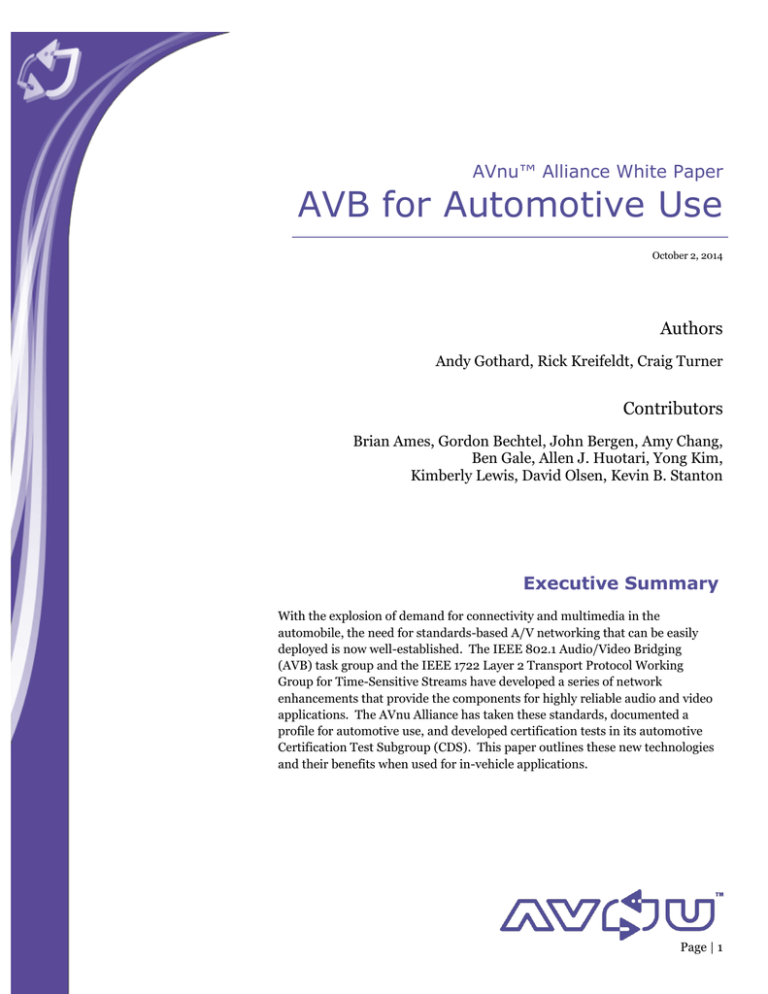
AVnu™ Alliance White Paper
AVB for Automotive Use
October 2, 2014
Authors
Andy Gothard, Rick Kreifeldt, Craig Turner
Contributors
Brian Ames, Gordon Bechtel, John Bergen, Amy Chang,
Ben Gale, Allen J. Huotari, Yong Kim,
Kimberly Lewis, David Olsen, Kevin B. Stanton
Executive Summary
With the explosion of demand for connectivity and multimedia in the
automobile, the need for standards-based A/V networking that can be easily
deployed is now well-established. The IEEE 802.1 Audio/Video Bridging
(AVB) task group and the IEEE 1722 Layer 2 Transport Protocol Working
Group for Time-Sensitive Streams have developed a series of network
enhancements that provide the components for highly reliable audio and video
applications. The AVnu Alliance has taken these standards, documented a
profile for automotive use, and developed certification tests in its automotive
Certification Test Subgroup (CDS). This paper outlines these new technologies
and their benefits when used for in-vehicle applications.
Page | 1
About AVnu Alliance
The AVnu Alliance enables deterministic networking via certification of
compliance and interoperability for devices using open IEEE standards. The
AVnu certification program ensures interoperability of networked devices in
a broad range of applications including professional AV, automotive,
industrial control and consumer. The organization works with standards
bodies and alliances to create an open path to deterministic networking
based on 802.1 Audio Video Bridging (AVB) / Time Sensitive Networking
(TSN) base standards, enabling designers and engineers to architect these
standards into their product plans.
© 2009 and 2014 by AVnu Alliance. All rights reserved. AVnu™, AVnu
Alliance™, and AVnu design and logos are trademarks and of the AVnu
Alliance. All other names and logos are trademarks and/or service marks of
their respective owners. Specifications and content subject to change
without notice.
THIS DOCUMENT IS PROVIDED "AS IS" WITH NO WARRANTIES
WHATSOEVER, EXPRESS, IMPLIED, OR STATUTORY. AVnu Alliance
MAKES NO GUARANTEES, CONDITIONS OR REPRESENTATIONS AS
TO THE ACCURACY OR COMPLETENESS CONTAINED HEREIN. AVnu
Alliance disclaims all liability, including liability for infringement, of any
proprietary or intellectual property rights, relating to use of information in
this document. No license, express or implied, by estoppel or otherwise, to
any proprietary or intellectual property rights is granted herein.
Page | 2
Introduction
Over the last ten years, consumer demand had
driven a large increase in audio and video
features and options in the automobile. Once
only found in luxury cars, features such as DVD
playback, backup cameras, and navigation have
become commonplace options in many
mainstream automobiles. Rear Seat
Entertainment (RSE) units are growing in
sophistication with more sources and choices at
your fingertips. Each of these options has added
to the need and desire for a common networking
architecture in the automobile.
While automotive OEMs around the globe have
embraced the concept of low-bandwidth vehicle
communication networking with Controller Area
Network (CAN) being adopted almost
universally, the unique and varied challenges in
vehicle multimedia networking (e.g., bandwidth,
QOS, scalability, cost, economies of scale, open
vs. proprietary, and supplier choice) has left the
door open for much debate over the best
solution for multimedia from both a technical
and commercial perspective.
Historically, the implementation of packetswitched networks has been avoided for vehicle
multimedia applications due to their nondeterministic nature. The recent work of the
IEEE 802.1 Audio Video Bridging (AVB) task
group and the IEEE 1722 AVTP working group,
offers a standards-based approach for highly
reliable networked transmission for low-latency
applications like those found within an
automobile. While AVB protocols can be used
on more than one physical layer type, this paper
will focus on the application of AVB over
Ethernet. Wired Ethernet networks employing
AVB protocols are very well suited to automotive
deployment due to both simplified cabling and
reliability of a hard-wired solution.
whitepaper outlines the features and benefits of
in-vehicle networking using the AVB
technologies.
Ethernet AVB at-a-glance
AVB is an enhancement to the Ethernet suite of
open standards. It provides quality of service
(QoS) guarantees, a network time
synchronization service, and a related transport
protocol for transmission of time-sensitive
traffic that together allow a network to handle
audio-visual (AV) data. In the automotive
environment, it can also satisfy more generalized
time-sensitive networking requirements,
opening up the possibility of a single network
that handles infotainment, body control, driver
assistance and even safety-critical functions.
To do this, AVB uses a number of important
concepts. It introduces “priority”, to specify that
some data streams are time-sensitive and
distinct from ordinary traffic that gets carried on
a best-effort basis. The idea of “reservation”
means that the network can set aside a certain
amount of guaranteed bandwidth to handle this
high-priority traffic. The concept of “network
time”, along with rigorous latency specifications,
enables synchronized AV playback through
simultaneous packet delivery. Standard traffic
shaping and forwarding rules are also included.
Finally, there are standardized methods for
discovery, enumeration and control, allowing
systems to be built and configured quickly and
easily.
More details about the individual parts of the
standard and associated technologies can be
found in the technology overview at the end of
this document.
A primary market focus of the AVnu Alliance is
the successful deployment of AVB for streaming
audio/video into the automotive space. This
Page | 3
AVB Benefits for
automotive markets
Simpler cabling lowers weight and
increases reliability
A networked approach to cabling reduces the
component cost and design complexity of the invehicle wiring harness. It boosts reliability by
cutting the number of interconnects, while
reducing weight and hence increasing fuel
efficiency.
The use of multiplexed or networked based
control communication in vehicles is already
commonplace, starting with basic control
messaging and the widespread adoption of the
CAN protocol. As the A/V content associated
with infotainment systems has increased, it has
become impractical to continue with point-topoint dedicated connections such as shielded
LVDS cables.
A healthy ecosystem
The creators of AVB chose to base it on Ethernet
for more than just sound technical reasons.
Ethernet is the most robust, most deployed,
most familiar networking technology on earth.
The decision to create an open, standard
technology was intended to build on these
advantages. Open standards foster strong,
competitive ecosystems, and multiple silicon
providers have already deployed AVB into their
products. Further, the work of the AVnu
Automotive CDS has defined a usage profile for
AVB and is developing an associated
certification process. This will allow OEMs to
specify compliance and interoperability
requirements that can be met by a variety of
Tier-1 automotive suppliers, who in turn can
architect their solutions without dependence on
a single technology provider.
This approach contrasts sharply with the
previous situation in the automotive industry.
The predominant technology for in-vehicle
infotainment networking has traditionally been
MOST®, but many have felt that the proprietary
nature of the MOST technology has slowed
development and hampered its adoption. As
early as Nov 2008, the Hansen Report observed
that “…industry players today believe that
compared with CAN, LIN, and FlexRay, MOST is
not nearly open enough.” The report goes on to
predict that “Without more openness and
greater affordability, MOST could in several
years give way to alternatives, for example
Ethernet.” This prediction is now coming to
pass, as MOST gets overtaken by newer, more
open technologies.”
Certified interoperability
AVB is not just open – it is a set of IEEE
standards backed by a robust and rigorous set of
conformance and interoperability (C&I) defined
in its respective Protocol Implementation
Conformance Statements (PICS). AVnu C&I
extends IEEE PICS to include those specific to
the Automotive use case. AVnu Alliance
certification programs include independent
testing ensuring interoperability across a broad
ecosystem of A/V devices.
The result is that OEMs get assurances that their
products will work with other AVB-certified
devices; and auto makers get a fertile ecosystem
of suppliers that grows and quickly reaches
critical mass.
Predictability and high reliability
The AVB core technologies of prioritization,
reservation, traffic shaping, and universal timing
allow the construction of networks with the
demanding predictability and reliability
requirements of the automotive industry.
The IEEE 802.1Q Queuing and Forwarding
Protocol (Qav) is key to this predictability. It
schedules high-priority traffic through the
network, ensuring that lower-priority data does
not interfere with time-sensitive content.
Bandwidth Reservation reserves end-to-end
bandwidth availability across the network before
Page | 4
an A/V stream starts, guaranteeing that
bandwidth until it is explicitly released.
Bandwidth reservations can be preconfigured
statically for a minimal startup. A system
configured with Static Reservations for the
expected traffic patterns and thereby reserving
the required network resources is the default
functionality in automotive use cases.
The IEEE 802.1Q Stream Reservation Protocol
(SRP) can be used to add a further layer of
flexibility. It allows endpoints to dynamically
reserve and release stream bandwidth, enabling
reliable A/V streaming without the need for the
OEM to perform extensive hand tuning of the
network for every different option package or
future configuration of the vehicle.
Implementation of SRP is option in automotive
use case.
Many-to-many configuration flexibility
Creating an in-vehicle network that deals with a
broad range of content and control signals is a
challenging task. The network needs to play back
AV program material from a variety of sources to
a number of destinations, provide features such
as program muting in the event of an incoming
cellphone call, and deliver content like warning
indicators and turn-by-turn navigation
commands that must be assured a timely
delivery. This requires a network that is
configured with reservations to cope with these
requirements from the outset.
Implementation of SRP is optional and not
required in automotive use case. The need for
many-to-many communication is one of the
fundamental attractions for auto makers of
moving to a networked AV system and away
from point-to-point connections.
Low Latency
Many automotive applications require very low
latency. Devices such as back-up or driver assist
cameras, Bluetooth microphones and various
signal tones are obvious examples. Just as
important are the constraints imposed by
outside-world systems – for instance a
handsfree car kit needs to conform to the latency
requirements of the cellular network. The AVB
protocols can deliver against the most rigorous
latency requirements.
Precise Synchronization
The overall aim of an automotive AV network is
to deliver a high-quality listening and viewing
experience to the user in the vehicle by allowing
AV streams to be reconstructed faithfully at the
end points. In addition, the auto maker gains the
opportunity to build a flexible network that can
accommodate a diverse range of content types,
sources and playback nodes.
The key to both of these requirements is
synchronization.
Technically, synchronization has two primary
purposes: first, it provides a common time base
for sampling data at a source device and
presenting that data at one or more destination
devices with the same relative timing; second, it
allows multiple streams to be synchronized with
each other (for example front and rear audio).
AVB achieves this via IEEE 802.1AS Precision
Time Protocol (PTP). This provides a common
time-reference base to all nodes on the network,
called the “wall clock”. IEEE 1722 AV Transport
Protocol then introduces the concept of
“presentation time”, derived from the common
“wall clock”, allowing the sending node to
specify when (in network time) a packet should
be presented at the receiving end.
Network nodes retain their own local clock: but
by exchanging timestamp information, they
track “where they stand” in relation to network
time. At the receiving end, the original sample
clock can therefore be reconstructed, not only
allowing an accurate, low-jitter delivery of the
content, but also allowing a single AVB network
Page | 5
to accommodate any number of different sample
rates and device types.
Fast boot
One of the most testing requirements placed on
automotive multimedia systems is the need to
provide “early audio” and “early video”. The
system must boot fast and be ready to provide
audio and video functionality on the order of a
second after the car is started. Audio is used to
play safety chimes; video is used for rear-view
cameras. Both use cases are mandated by
NHTSA to be available within 2 seconds after
starting the car.
To satisfy these needs, the AVnu Alliance has
created a dedicated automotive profile that
streamlines the startup process of automotive
Ethernet AVB products. In particular, the
profile uses a pre-configured fixed clock tree for
fast network time synchronization, and
preconfigured traffic stream configurations,
eliminating the delay associated with dynamic
set up of AVB stream reservations.
Scalable, versatile topologies
Unlike MOST, where the total network
bandwidth is shared among all connected
devices, AVB networks utilize bandwidth only
between source and destination node
connections. This conservation of bandwidth
allows substantially more data to flow on an AVB
network vs. a MOST network even at equivalent
network bitrates. Topologies such as stars and
trees are easily supported. The availability of a
multicast service, for one-to-many transmission,
further increases bandwidth efficiency.
Fig 1 MOST ring topology. All devices see entire
network traffic from every other devices
Fig 2 Possible AVB architecture. In this example, the
camera signals from the front of the car only pass to
the drives assistance module.
Designers also have a flexible choice of
compatible speeds. For example a given vehicle
design can easily mix and match high-bandwidth
gigabit links with lower-bandwidth 100Mbps.
Substantial technological investment by the
networking community has ensured this
interoperability at the same time that speeds
have been pushed upward to 10Gbps and even
100 Gbps. By comparison, the three published
speeds of MOST - MOST25, MOST50, and
MOST150 - are not compatible. The entire
network must be at the same speed, reducing
flexibility and adding unnecessary cost into the
low-bandwidth devices to meet the needs of
high-bandwidth devices.
Page | 6
Ethernet AVB Use Cases
Lip-synced Multimedia Playback
Providing truly lip-synced playback of AV
content across the various multimedia devices in
a car environment is a core automotive use case
for Ethernet AVB.
The content, whether from a pre-installed DVD
player in the front console or from a wireless
mobile device, can be delivered simultaneously
to multiple front and rear seat displays, the car’s
primary audio amplifier and even connected
headsets. This ensures an enjoyable AV
experience for all passengers, regardless of the
content being played or the desired playback
constellation.
The following figure shows an example with two
RSE displays showing the video playback of a
DVD whilst the audio is transmitted on a totally
separate path to the amplifier. Ethernet AVB
allows all three to be precisely synchronized.
Fig 3. DVD player with multiple audio/video paths
DVD Player
Rear Seat Display
Amplifier
Rear Seat Display
Connected Car Applications
In a connected car, the availability of and the
inevitable dependency on external data is high.
Whether it is streamed AV content, online maps
for navigation, general Internet media coming
into the car or various telematics data and
service requests being sent out of the car, the
demand for network bandwidth is high.
The ability to leverage a single vehicle network
for delivering all of this data as well as internal
AV data, while still respecting the significantly
different QoS requirements for different data is a
powerful advantage of Ethernet AVB.
Advanced Driver Assistance Systems
The flexibility and high bandwidth of an AVB
network enables the realization of many modern
Advanced Driver Assistance Systems (ADAS).
For example, an array of cameras can be
connected to provide a synchronized 360°
surround view of the vehicle’s environment. This
view can be further enhanced with additional
sensor data, sent and synchronized over the
same network, to provide an augmented driver
awareness system to increase safety for both
motorists and pedestrians.
Diagnostics
Vehicle diagnostics are highly desired by
automotive OEMS to troubleshoot vehicle
problems at automotive OEM assembly lines
and dealer service stations. No physical
diagnostics exist for CAN and only ring break
diagnostics exist for MOST.
On the other hand, modern Ethernet PHYs have
substantial physical layer diagnostic capabilities
which include: automatic detection and
compensation of swapped pairs, cable breaks,
and detection and compensation for kinks and
impedance mismatches which can reduce
bandwidth. Utilizing these established and
proven Ethernet diagnostics, both assembly and
service issues can be more quickly found and
fixed.
Brief Technology Overview
For a more thorough treatment of the AVB
technologies, see technical resources available
on AVnu website Knowledge Center and Council
Material.
The IEEE 802.1 AVB and IEEE 1722 standards
form the foundation of the technology promoted
by the AVnu Alliance and—like other IEEE
standards—describe interworking/bridging
between various network link technologies. It’s
important to note, however, that this is not
intended to imply that the services provided by
Page | 7
the AVB standards over every kind of network
link are identical, since each link technology has
different characteristics.
Below are the foundational standards.
IEEE 802.1AS (PTP): “Timing and
Synchronization for Time-Sensitive
Applications in Bridged Local Area
Networks.” This auto-selects a device to
be the master clock, which then
distributes time throughout the bridged
LAN / IP subnet to all other nodes. The
802.1AS clock is not used as a media
clock. Rather, the 802.1AS time is used
as a shared clock reference between
nodes which is used to port a media
clock from talker to listener. Such a
reference removes the need to fix the
latency of packet delivery, or compute
long running averages in order to
estimate the actual media rate of the
transmitter in the presence of
substantial network jitter. IEEE 802.1AS
is based on the ratified IEEE 1588-2008
standard.
IEEE 802.1Q-2012 (SRP): Developed as
a P802.1Qat project, “Virtual Bridged
Local Area Networks - Amendment 9:
Stream Reservation Protocol (SRP).”
This allows a stream reservation to be
established between a talker and listener
in a bridged LAN / IP subnet.
IEEE 802.1Q2012 (FQTSS): Developed
as a P802.1Qav project, “Virtual Bridged
Local Area Networks - Amendment 11:
Forwarding and Queuing for TimeSensitive Streams.” This describes a
token-bucket method for shaping
network traffic such that the latency and
bandwidth of reserved streams can be
controlled.
IEEE 802.1BA: “Audio/Video Bridging
(AVB) Systems” This references and
defines relevant IEEE 802.1 and other
standards for use in building AVB
systems.
IEEE 1722 “Layer 2 Transport Protocol
for Time-Sensitive Applications in
Bridged LANs.” This specifies the
protocol, data encapsulations, and
presentation time procedures used to
ensure interoperability between audioand video-based end stations that use
standard networking services provided
by all IEEE 802 networks meeting
quality-of-service requirements for timesensitive applications.
By precisely time-stamping special packets as
they leave and arrive at the interface or PHY,
PTP can measure and compensate for all
queuing and time-of-flight transmission delays.
To make use of 802.1AS, streams are expected to
include a presentation time which then is used
to regenerate the sample clock by means of
cross-time stamping with the network time.
With 802.1AS and presentation timeencapsulated streams, an AVB network
inherently supports an arbitrary number of
different media sample rates and clock sources
as the destination devices will each synchronize
to their corresponding source device. An AVB
network also then provides the mechanism to
synchronize different paths through the
network.
The IEEE 802.1Q Stream Reservation Protocol
(SRP) provides mechanisms for reserving stream
bandwidth that allows endpoint applications to
dynamically configure the routes. SRP is an
optional feature for automotive. In order to
simplify end-points and achieve faster network
startup, the default behavior is instead a fixed
network that is pre-configured with the outcome
that SRP would have arrived at had it run.
Whether pre-configured stream reservation or
SRP used, both works hand-in-hand with the
IEEE 802.1Q Forwarding and Queuing Time
Sensitive Streams Protocol (FQTSS). FQTSS
schedules time-sensitive A/V streaming data,
ensuring timeliness through the network.
Regular non-streaming traffic such as IP-based
control or meters is treated in such a way that it
cannot interfere with reserved AVB traffic.
Page | 8
The AVnu Automotive Ethernet AVB Functional
And Interoperability Specification takes these
standards and defines configuration and options
optimized for the automotive use case,
including: - A fixed pre-configured 802.1AS clock
tree with built in timing redundancy
- Pre-configured traffic streams
- Startup meeting NHTSA requirements
- AVB traffic classes optimized for
Automotive Audio
- Mechanisms to optimize AVB
performance in low-cost ECUs and endpoint.
- Diagnostics
Conclusion
The new technology from IEEE 802.1 AVB task
group provides a critical component for
successful deployment of Ethernet in the vehicle
for applications such as infotainment and driver
assistance. AVnu Alliance provides
interoperable automotive use profile and
certification tests to validate embodiment of
these requirements. The reliable delivery of lowlatency precisely synchronized audio and video
combined with the massive industry investment
provides a compelling solution for nextgeneration systems. The AVB protocols are an
open standard, allowing multiple suppliers to
deliver silicon solutions for automotive usage.
For more information, please contact the AVnu
Alliance at www.AVnu.org.
Page | 9

